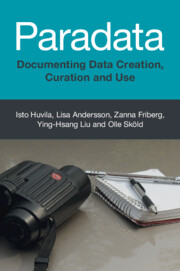Refine search
Actions for selected content:
48556 results in Computer Science
The future of learning or the future of dividing? Exploring the impact of generative artificial intelligence on higher education—CORRIGENDUM
-
- Journal:
- Data & Policy / Volume 7 / 2025
- Published online by Cambridge University Press:
- 06 August 2025, e56
-
- Article
-
- You have access
- Open access
- HTML
- Export citation
Development and kinematics/dynamics analysis of novel hybrid hand with flexible coupling chain
-
- Journal:
- Robotica , First View
- Published online by Cambridge University Press:
- 06 August 2025, pp. 1-22
-
- Article
- Export citation
Forecasting displacement and solutions for decision-making in volatile contexts: a case study from Ukraine
- Part of
-
- Journal:
- Data & Policy / Volume 7 / 2025
- Published online by Cambridge University Press:
- 06 August 2025, e55
-
- Article
-
- You have access
- Open access
- HTML
- Export citation

Paradata
- Documenting Data Creation, Curation and Use
-
- Published online:
- 05 August 2025
- Print publication:
- 07 August 2025
-
- Book
-
- You have access
- Open access
- Export citation
On a new family of r-modified reliability systems
-
- Journal:
- Probability in the Engineering and Informational Sciences / Volume 39 / Issue 4 / October 2025
- Published online by Cambridge University Press:
- 05 August 2025, pp. 605-618
-
- Article
-
- You have access
- Open access
- HTML
- Export citation
Human–robot task distribution metrics in car battery recycling: a case study on screw removal
-
- Journal:
- Robotica , First View
- Published online by Cambridge University Press:
- 01 August 2025, pp. 1-21
-
- Article
- Export citation
Consolidation and change: Exploring the impact of anger and network dynamics on inequality belief systems
- Part of
-
- Journal:
- Network Science / Volume 13 / 2025
- Published online by Cambridge University Press:
- 01 August 2025, e9
-
- Article
-
- You have access
- Open access
- HTML
- Export citation
Design knowledge for digital health implementation: a scoping review based on citation analysis
-
- Journal:
- Design Science / Volume 11 / 2025
- Published online by Cambridge University Press:
- 31 July 2025, e31
-
- Article
-
- You have access
- Open access
- HTML
- Export citation
Generalized equilibrium distributions
- Part of
-
- Journal:
- Probability in the Engineering and Informational Sciences , First View
- Published online by Cambridge University Press:
- 31 July 2025, pp. 1-27
-
- Article
-
- You have access
- Open access
- HTML
- Export citation
Knowledge graph-assisted design-by-analogy: promoting product innovation through structured analogical knowledge retrieval
-
- Article
-
- You have access
- Open access
- HTML
- Export citation
Noise sensitivity on affine Weyl groups
- Part of
-
- Journal:
- Combinatorics, Probability and Computing / Volume 34 / Issue 5 / September 2025
- Published online by Cambridge University Press:
- 31 July 2025, pp. 754-779
-
- Article
- Export citation
Peace in every shot: How Kodak changed the way we see war
- Part of
-
- Journal:
- Memory, Mind & Media / Volume 4 / 2025
- Published online by Cambridge University Press:
- 30 July 2025, e8
-
- Article
-
- You have access
- Open access
- HTML
- Export citation
Evaluating daylight performance of AI-generated housing plans via diffusion models and climate-based simulation
-
- Article
-
- You have access
- Open access
- HTML
- Export citation
The Grothendieck construction in the context of tangent categories
-
- Journal:
- Mathematical Structures in Computer Science / Volume 35 / 2025
- Published online by Cambridge University Press:
- 29 July 2025, e19
-
- Article
-
- You have access
- Open access
- HTML
- Export citation
To measure the straight distance, by travelling the winding way
- Part of
-
- Journal:
- Memory, Mind & Media / Volume 4 / 2025
- Published online by Cambridge University Press:
- 29 July 2025, e7
-
- Article
-
- You have access
- Open access
- HTML
- Export citation
Tree semantic segmentation from aerial image time series
-
- Journal:
- Environmental Data Science / Volume 4 / 2025
- Published online by Cambridge University Press:
- 29 July 2025, e37
-
- Article
-
- You have access
- Open access
- HTML
- Export citation



